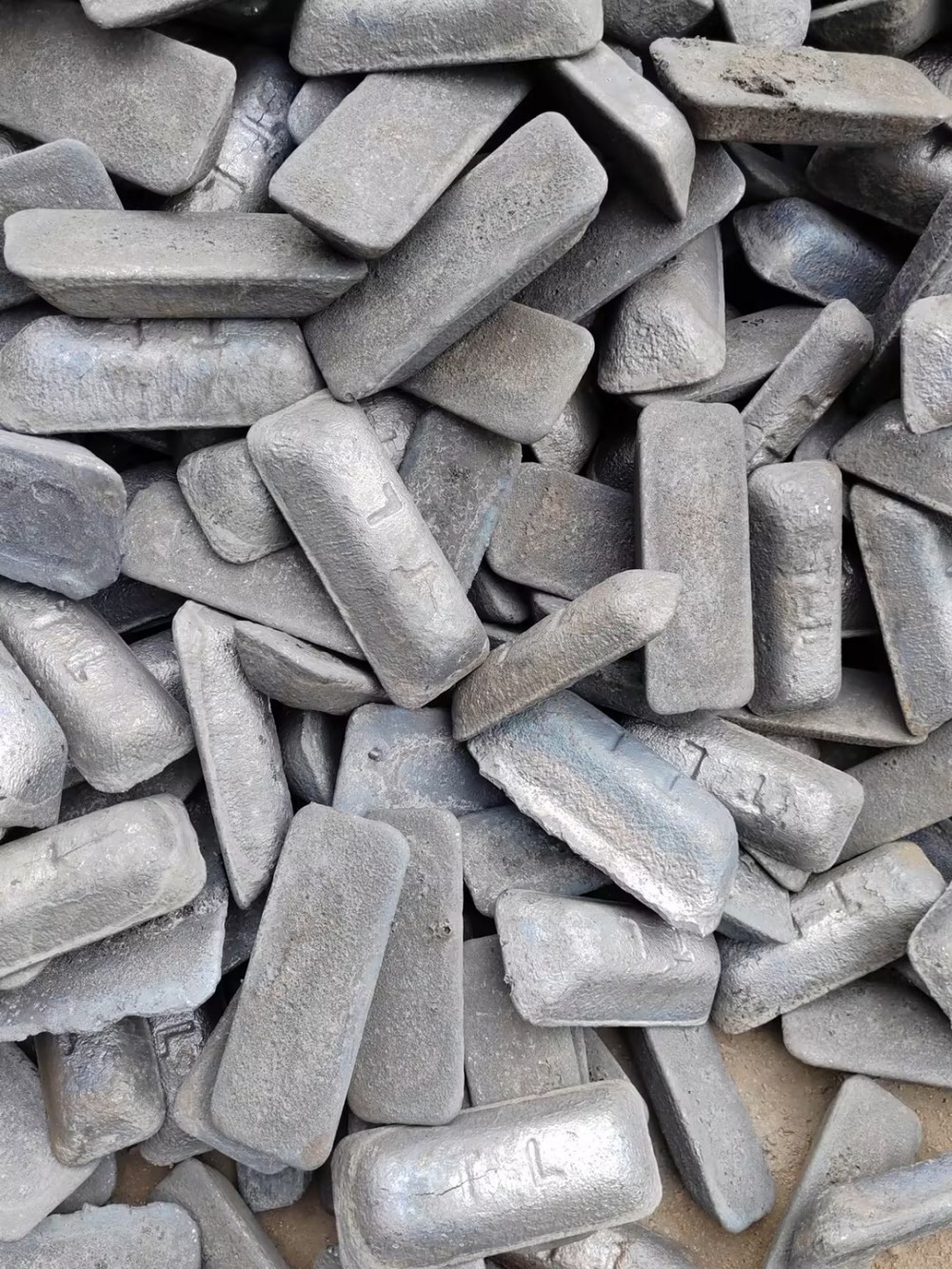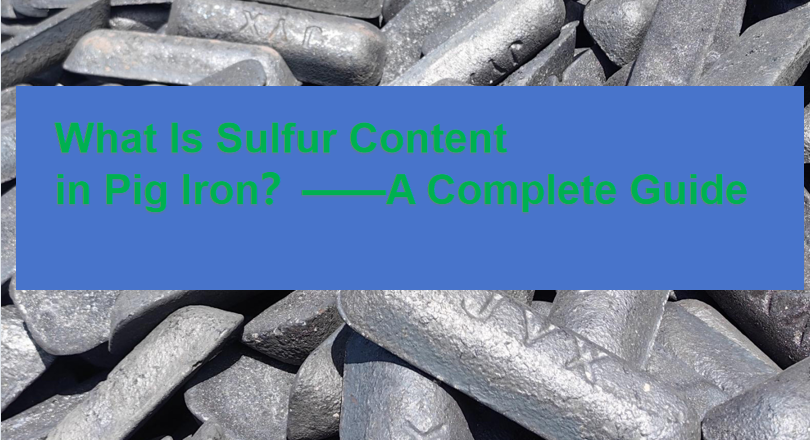How Does Sulfur Content Affect Pig Iron Quality?——A Complete Guide
2025-08-01 10:40:46 hits:0
Table of Contents
II. Importance of Sulfur Content in Pig Iron in the Iron and Steel Industry
III. Relationship Between Sulfur and Other Elements in Pig Iron
IV. Significance of Sulfur Content in Pig Iron in Related Testing Fields
V. Impact of Sulfur Content in Pig Iron on Market Supply and Demand
VI. Related Research and Analysis Methods of Sulfur Content in Pig Iron
VII. Case Studies of Sulfur Content in Pig Iron in Different Industries
I. Basic Meanings of Sulfur Content in Pig Iron
1. Definition of Sulfur Content in Pig Iron
The sulfur content in pig iron refers to the proportion of sulfur element in the iron-carbon alloy known as pig iron. Sulfur usually exists in the form of sulfides in pig iron and is an impurity element in it. From a chemical perspective, the presence of sulfur has a significant impact on the properties of pig iron, as follows:
In the casting process, excessively high sulfur content will deteriorate the fluidity of pig iron, leading to defects such as pores and cracks in castings, thus affecting the quality and performance of castings.
In terms of mechanical properties, sulfur will reduce the toughness and ductility of pig iron, making it more brittle and hard, and prone to fracture when under stress.
2. Common Contexts of Sulfur Content in Pig Iron in the Industry
In the iron and steel production industry, the sulfur content in pig iron is a much-concerned indicator. When purchasing pig iron, iron and steel enterprises will strictly specify the sulfur content standards of pig iron to ensure the smooth progress of the subsequent steelmaking process and the stability of steel quality. For example, in the production of some high-end steel products, the requirement for sulfur content in pig iron is very strict, generally requiring the sulfur content to be below 0.02% or even lower.
In the academic research field, researchers also conduct in-depth studies on the sulfur content in pig iron, exploring methods and technologies to reduce sulfur content, as well as the influence mechanism of sulfur content on the microstructure and properties of pig iron.
3. Characteristics of Sulfur Content in Different Types of Pig Iron
Different types of pig iron, due to differences in their uses and production processes, have different characteristics in terms of sulfur content:
Steelmaking pig iron: The sulfur content is usually controlled below 0.03% - 0.05%. Although desulfurization can be carried out during the steelmaking process, an excessively high initial sulfur content will increase the desulfurization cost and affect the steel quality, especially for steels requiring high toughness.
Foundry pig iron: The sulfur content is generally between 0.03% - 0.06%. Casting has certain requirements for the fluidity of pig iron. Too low sulfur content may affect the fluidity, but too high will lead to casting defects, so a balanced control is needed.
Ductile iron: The requirement for sulfur content is strict, usually needing to be below 0.02%. Sulfur will interfere with the graphitization process of graphite, leading to poor spheroidization and affecting mechanical properties, so it must be strictly controlled.
High-purity pig iron: The sulfur content is extremely low, generally below 0.01%. It is mainly used in fields with extremely high purity requirements, such as precision casting and special alloy manufacturing, where the impact of impurities needs to be minimized.
II. Importance of Sulfur Content in Pig Iron in the Iron and Steel Industry
1. Iron and Steel Production Process and Sulfur Content in Pig Iron
In the iron and steel production process, pig iron is one of the main raw materials for steelmaking. The sulfur content in pig iron has an important impact on the entire steelmaking process. When the sulfur content in pig iron is too high, it will increase the difficulty and cost of desulfurization in the steelmaking process. During steelmaking, various desulfurization processes need to be adopted to reduce the sulfur content to meet the requirements of steel quality. Common desulfurization methods are:
External desulfurization: Desulfurization treatment is carried out before the molten iron enters the converter or electric furnace. By adding desulfurizers such as lime and magnesium powder to the molten iron, sulfur reacts with the desulfurizers to form sulfides, thereby reducing the sulfur content in the molten iron.
Internal desulfurization: Desulfurization is carried out in the steelmaking furnace. By adjusting parameters such as temperature and atmosphere in the furnace, sulfur is promoted to react with desulfurizers to achieve the purpose of desulfurization.
2. Steel Quality and Sulfur Content Strategy in Pig Iron
For iron and steel enterprises, controlling the sulfur content in pig iron is crucial to ensuring steel quality. Different types of steel have different requirements for sulfur content:
Construction steel has relatively low requirements for sulfur content, but it should not be too high, otherwise, it will affect the welding performance and structural safety of the steel.
For some special-purpose steels, such as aerospace steel and high-strength automotive steel, the requirements for sulfur content are very strict.
Iron and steel enterprises need to reasonably control the sulfur content in pig iron and adopt appropriate sulfur content strategies according to market demand and product positioning. At the same time, attention should also be paid to the stability of sulfur content to avoid excessive fluctuations in sulfur content affecting the consistency of steel quality.
3. Sulfur Content Competition and Long-Tail Strategy
In the iron and steel market, the competition in the high-end steel market with extremely low sulfur content requirements is very fierce. For example, in the high-end automotive steel market, major iron and steel enterprises are competing for this market share. To stand out in the competition, iron and steel enterprises can adopt the long-tail strategy.
The long-tail strategy refers to producing pig iron and steel with special sulfur content requirements for some specific and niche market demands. For example, producing pig iron with extremely low sulfur content for some special machinery manufacturing enterprises to manufacture high-precision components. Although the market scale of these special demands is relatively small, they are more targeted and have higher profit margins.
III. Relationship Between Sulfur and Other Elements in Pig Iron
Sulfur does not exist in isolation in pig iron. It has complex interactions with other elements, and these interactions will jointly affect the properties of pig iron:
Relationship with iron: Sulfur and iron easily form FeS, which has a relatively low melting point (about 1190℃). When pig iron is processed at high temperatures, FeS will enrich at grain boundaries, causing hot brittleness in pig iron and reducing high-temperature plasticity.
Relationship with carbon: When the carbon content is high, the harm of sulfur is relatively more obvious. Because carbon will promote the segregation of sulfur at grain boundaries, exacerbating the tendency of hot brittleness. Therefore, high-carbon pig iron has stricter control over sulfur content.
Relationship with manganese: Manganese has a strong affinity with sulfur and can preferentially combine with sulfur to form MnS. MnS has a high melting point (about 1620℃) and is not easy to enrich at grain boundaries, which can reduce the hot brittleness hazard of sulfur. Therefore, adding an appropriate amount of manganese to pig iron can offset the adverse effects of sulfur to a certain extent.
Relationship with silicon: Silicon has a relatively small impact on sulfur, but high silicon content may change the structure of pig iron and indirectly affect the distribution of sulfur, but this impact is usually not as significant as that of manganese.
IV. Significance of Sulfur Content in Pig Iron in Related Testing Fields
1. Testing Methods and Sulfur Content
In the production and use of pig iron, accurate detection of sulfur content is crucial. At present, common sulfur content detection methods are:
Chemical analysis method: It converts sulfur into measurable substances through chemical reactions, and then determines the sulfur content through weighing or titration. For example, the combustion-iodometric method is a commonly used chemical analysis method. It burns the pig iron sample at high temperature to convert sulfur into sulfur dioxide, and then titrates sulfur dioxide with iodine standard solution to calculate the sulfur content.
Instrumental analysis method: It has the advantages of speed, accuracy, and high sensitivity, such as infrared absorption method and spectral analysis method. The infrared absorption method uses the characteristic that sulfur dioxide generated by the combustion of sulfur at high temperature absorbs infrared light of a specific wavelength, and determines the sulfur content by measuring the intensity of the absorbed light.
2. Role of Sulfur Content Detection in Quality Control
Sulfur content detection plays an important identifying and guiding role in pig iron quality control:
Iron and steel enterprises can timely detect changes in sulfur content during production through regular detection of sulfur content in pig iron and take corresponding measures to adjust. For example, if it is detected that the sulfur content in pig iron exceeds the standard, the enterprise can timely adjust the production process, increase investment in desulfurization links, or change raw material suppliers.
Before the products leave the factory, the sulfur content in pig iron is strictly detected to ensure that the product quality meets the standard requirements.
The results of sulfur content detection can also provide data support for the production management and quality improvement of enterprises, helping enterprises optimize production processes and improve production efficiency and product quality.
V. Impact of Sulfur Content in Pig Iron on Market Supply and Demand
1. Matching Market Demand with Sulfur Content
In terms of market demand, different industries have different requirements for the sulfur content in pig iron:
The foundry industry has relatively low requirements for the sulfur content in pig iron because the casting process has certain requirements for the fluidity and toughness of pig iron, and an appropriate sulfur content can improve the fluidity of pig iron to a certain extent.
The machinery manufacturing industry has high requirements for the sulfur content in pig iron because mechanical parts have strict requirements for strength, toughness, and processing performance. Excessively high sulfur content will affect the quality and service life of parts.
Iron and steel enterprises need to produce pig iron products with different sulfur contents according to market demand to meet the needs of different customers. At the same time, market demand will also change with economic development and technological progress, and iron and steel enterprises need to timely adjust their production strategies to adapt to market changes.
2. Market Research and Sulfur Content Analysis
Market researchers will understand market dynamics and consumer preferences by analyzing the market demand for pig iron with different sulfur contents, including:
Providing a basis for iron and steel enterprises to formulate production and sales strategies by analyzing the differences in demand for sulfur content in pig iron in different regions and industries.
Predicting the changing trend of market demand by comparing market demand data in different time periods. For example, if it is found that the demand for low-sulfur pig iron in a certain industry is on the rise, iron and steel enterprises can increase investment in the production of low-sulfur pig iron to improve market share.
Helping iron and steel enterprises understand the product situation of competitors and analyze the sulfur content strategies of competitors to formulate more competitive market strategies.
VI. Related Research and Analysis Methods of Sulfur Content in Pig Iron
1. Sulfur Content Research Tools
There are many professional research tools that can help us understand the sulfur content in pig iron:
Chemical analysis instruments in laboratories can accurately measure the sulfur content in pig iron, providing data support for research.
Some advanced testing equipment, such as scanning electron microscopes and energy dispersive spectrometers, can be used to analyze the distribution and existing forms of sulfur in pig iron, helping researchers deeply understand the influence mechanism of sulfur on the properties of pig iron.
Some industry databases and statistical software can sort out and analyze the relevant data of sulfur content in pig iron, providing references for enterprise production decisions.
Through these tools, we can understand the differences in sulfur content of pig iron from different producing areas and with different production processes, as well as the relationship between sulfur content and other factors, thus providing a basis for optimizing production processes and improving product quality.
2. Data Analysis and Sulfur Content Evaluation
After obtaining a large amount of data on sulfur content in pig iron, data analysis and evaluation are needed:
The quality stability of pig iron can be evaluated from multiple angles such as the average value, standard deviation, and changing trend of sulfur content. For example, if the standard deviation of sulfur content in a batch of pig iron is large, it indicates that the sulfur content of this batch of pig iron fluctuates greatly and the quality stability is poor.
Mathematical models can be established to analyze the correlation between sulfur content and other factors, such as production process parameters and raw material quality.
Through data analysis and evaluation, we can find problems in the production process and take timely measures to improve. For example, if it is found that there is a significant correlation between sulfur content and a certain production process parameter, the sulfur content in pig iron can be controlled by adjusting this parameter.
Methods such as A/B testing can also be used to verify the impact of different production processes on the sulfur content in pig iron, continuously optimizing the production process and improving product quality.
VII. Case Studies of Sulfur Content in Pig Iron in Different Industries
1. Foundry Industry
Taking a foundry as an example, there are certain requirements for the sulfur content in pig iron when producing castings. If the sulfur content in pig iron is too high, it will cause defects such as pores and cracks in castings, affecting the quality and performance of castings. The specific manifestations are:
When casting large mechanical parts, the sulfur content in pig iron is required to be controlled at a low level to ensure the strength and toughness of the parts.
Foundries will select pig iron with appropriate sulfur content as raw materials and strictly control the sulfur content during production. At the same time, some process measures will be adopted to reduce the impact of sulfur content on casting quality, such as adding an appropriate amount of desulfurizer during the smelting process.
In the quality inspection of castings, sulfur content is also an important testing indicator, and only castings with sulfur content meeting the requirements can be sold on the market.
2. Machinery Manufacturing Industry
Mechanical manufacturing enterprises have high requirements for the sulfur content in pig iron when producing mechanical parts. For example, producing high-precision gears, shafts, and other parts requires the use of pig iron with extremely low sulfur content to ensure the processing performance and service life of the parts. Specific practices include:
Mechanical manufacturing enterprises will cooperate with iron and steel enterprises to customize low-sulfur pig iron that meets their requirements.
During the production process, pig iron will be strictly inspected and screened to ensure that the quality of the pig iron used meets the standards.
Attention is paid to the stability of sulfur content in pig iron, because fluctuations in sulfur content will affect the processing accuracy and quality consistency of parts. If the sulfur content is unstable, it may lead to dimensional deviations and surface quality problems of parts, affecting the overall performance of the product.
3. Construction Industry
In the construction industry, although the requirements for sulfur content in pig iron are relatively low, the impact of sulfur content on steel quality cannot be ignored:
If the sulfur content in the steel used in building structures is too high, it will affect the welding performance and structural safety of the steel.
When purchasing steel, construction enterprises will require steel suppliers to provide steel quality inspection reports, including indicators such as sulfur content. At the same time, construction enterprises will also conduct sampling inspections on the purchased steel to ensure that the steel quality meets the requirements of architectural design.
In some large construction projects, the quality requirements for steel are more stringent, and the sulfur content in pig iron will be more strictly controlled. For example, in important building structures such as high-rise buildings and bridges, the used steel must meet strict quality standards, including sulfur content standards, to ensure the safety and reliability of the building structure.
Conclusion
The sulfur content in pig iron has an important impact on iron and steel production, testing, market supply and demand, and applications in different industries. Understanding the relevant knowledge of sulfur content in pig iron, including the characteristics of sulfur content in different types of pig iron and the relationship between sulfur and other elements, is of great significance for iron and steel enterprises to optimize production processes, improve product quality, and for different industries to reasonably select and use pig iron.
Then, have you encountered any problems related to sulfur content in the actual production or use of pig iron? Welcome to leave a message in the comment area to share your experience and opinions, or you can share this article with more friends who are interested in the sulfur content in pig iron.
If you want to master the comprehensive knowledge of carbon, silicon, manganese, phosphorus, and sulfur at once, the summary blog "Comprehensive Analysis of Pig Iron Parameters" will be a good choice.
We have conducted special analyses for each element in pig iron. For more details, you can click directly to view: [Carbon in Pig Iron], [Silicon in Pig Iron], [Manganese in Pig Iron], [Phosphorus in Pig Iron], [Sulfur in Pig Iron].
If you have any thoughts, please feel free to contact us for communication.
You can also share this article with more friends who are interested in the chemical composition of pig iron.
About Tiegu Company
As a professional pig iron supplier, Tiegu Company covers various types such as steel-making pig iron, foundry pig iron, ductile iron, and high-purity iron, which can meet the diversified needs for manganese content in different scenarios. Through strict detection of raw material manganese content, real-time monitoring and precise adjustment during production, the company ensures stable product quality and provides customers with reliable pig iron supply solutions.
Contact Us
WhatsApp: 15256135588 (First 10 inquiries receive extra gifts)
E-mail:zbw@tiegu.net
Apply for Pilot: Click the link to get a customized solution (First batch of customers enjoy 20% discount)
Blog Author Profile
DAWN | Pig Iron & Castings Procurement Advisor 18 years in the foundry trenches give me an edge: I know how pig iron’s chemistry impacts casting quality and can troubleshoot defects like cracks and porosity. With a 1M MT/year pig iron and 60k MT/year casting output from our in-house factory, plus 200+ verified suppliers on our platform, we offer fast price comparisons. Expect a 24-hour inquiry response—my goal? Not just closing deals, but being your go-to partner in the foundry world.
18 years in the foundry trenches give me an edge: I know how pig iron’s chemistry impacts casting quality and can troubleshoot defects like cracks and porosity. With a 1M MT/year pig iron and 60k MT/year casting output from our in-house factory, plus 200+ verified suppliers on our platform, we offer fast price comparisons. Expect a 24-hour inquiry response—my goal? Not just closing deals, but being your go-to partner in the foundry world.


 en
en  fra
fra  de
de  ru
ru  ara
ara  gle
gle  it
it  jp
jp  kor
kor  th
th  zh
zh 



